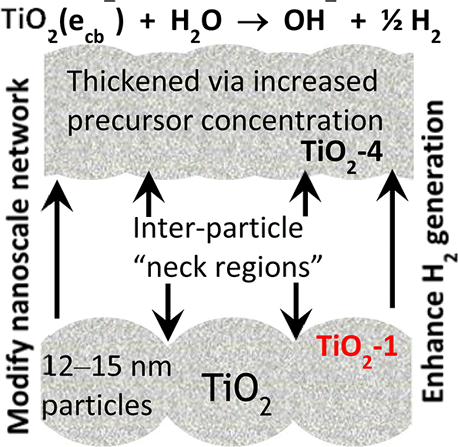当前位置:
X-MOL 学术
›
J. Phys. Chem. C
›
论文详情
Our official English website, www.x-mol.net, welcomes your
feedback! (Note: you will need to create a separate account there.)
Correlating Changes in Electron Lifetime and Mobility on Photocatalytic Activity at Network-Modified TiO2 Aerogels
The Journal of Physical Chemistry C ( IF 3.3 ) Pub Date : 2015-07-27 00:00:00 , DOI: 10.1021/acs.jpcc.5b04013 Paul A. DeSario , Jeremy J. Pietron , Dereje H. Taffa 1 , Ryan Compton , Stefan Schünemann 1 , Roland Marschall 1 , Todd H. Brintlinger , Rhonda M. Stroud , Michael Wark 1 , Jeffrey C. Owrutsky , Debra R. Rolison
The Journal of Physical Chemistry C ( IF 3.3 ) Pub Date : 2015-07-27 00:00:00 , DOI: 10.1021/acs.jpcc.5b04013 Paul A. DeSario , Jeremy J. Pietron , Dereje H. Taffa 1 , Ryan Compton , Stefan Schünemann 1 , Roland Marschall 1 , Todd H. Brintlinger , Rhonda M. Stroud , Michael Wark 1 , Jeffrey C. Owrutsky , Debra R. Rolison
Affiliation

|
We use intensity-modulated photovoltage spectroscopy (IMVS) and intensity-modulated photocurrent spectroscopy (IMPS) to characterize carrier dynamics in titania (TiO2) aerogels under photocatalytic conditions. By systematically increasing the weight fraction of the sol–gel precursor during TiO2 sol–gel synthesis, we are able to impart drastic changes in carrier transport/trapping and improve the photocatalytic activity of TiO2 aerogels for two mechanistically divergent photochemical reactions: reductive water splitting (H2 generation) and oxidative degradation of dichloroacetate (DCA). The lifetimes of photogenerated electrons increase in going from lowest-to-highest precursor concentrations, as measured by IMVS, indicating increasing site density for electron traps—a trend that correlates with an 8× improvement for photocatalytic H2 generation. Electron mobility in the aerogel films, as measured by IMPS, decreases with increasing trap density, further implicating the trapping sites as reactive sites. In contrast, photocatalytic DCA degradation—driven primarily by direct hole transfer to adsorbed DCA—depends only weakly on the electron dynamics in the film. Transient infrared spectroscopy shows no difference in carrier decay among the aerogel samples on picosecond time scales, indicating that changes in carrier dynamics within these networked nanomaterials are only observable at time scales measured by IMPV and IMPS. Correlating hole-mediated and electron-mediated photocatalytic activity with direct measurement of electron dynamics under photocatalytically relevant conditions and time scales comprises a powerful approach to determine how synthetic modifications to networked nanostructured photocatalysts affect the relevant physicochemical phenomena underlying their photocatalytic performance.
中文翻译:

网络修饰的TiO 2气凝胶的电子寿命和迁移率对光催化活性的相关变化
我们使用强度调制的光电压能谱(IMVS)和强度调制的光电流能谱(IMPS)来表征二氧化钛(TiO 2)气凝胶在光催化条件下的载流子动力学。通过在TiO 2溶胶-凝胶合成过程中系统地增加溶胶-凝胶前体的重量分数,我们能够使载流子迁移/捕获发生剧烈变化,并提高TiO 2气凝胶对两种机械发散的光化学反应的光催化活性:还原水分裂(H 2生成)和二氯乙酸盐(DCA)的氧化降解。根据IMVS的测量,从最低到最高的前驱物浓度,光生电子的寿命会增加,这表明电子陷阱的位点密度增加-这种趋势与光催化H 2的提高8倍相关一代。通过IMPS测量,气凝胶薄膜中的电子迁移率随陷阱密度的增加而降低,从而进一步将陷阱位点表示为反应位点。相反,主要由直接空穴转移到吸附的DCA引起的光催化DCA降解仅在很小程度上取决于薄膜中的电子动力学。瞬态红外光谱显示,在皮秒级时,气凝胶样品之间的载流子衰减没有差异,表明这些网络化纳米材料中载流子动力学的变化仅在IMPV和IMPS测量的时标下才能观察到。
更新日期:2015-07-27
中文翻译:

网络修饰的TiO 2气凝胶的电子寿命和迁移率对光催化活性的相关变化
我们使用强度调制的光电压能谱(IMVS)和强度调制的光电流能谱(IMPS)来表征二氧化钛(TiO 2)气凝胶在光催化条件下的载流子动力学。通过在TiO 2溶胶-凝胶合成过程中系统地增加溶胶-凝胶前体的重量分数,我们能够使载流子迁移/捕获发生剧烈变化,并提高TiO 2气凝胶对两种机械发散的光化学反应的光催化活性:还原水分裂(H 2生成)和二氯乙酸盐(DCA)的氧化降解。根据IMVS的测量,从最低到最高的前驱物浓度,光生电子的寿命会增加,这表明电子陷阱的位点密度增加-这种趋势与光催化H 2的提高8倍相关一代。通过IMPS测量,气凝胶薄膜中的电子迁移率随陷阱密度的增加而降低,从而进一步将陷阱位点表示为反应位点。相反,主要由直接空穴转移到吸附的DCA引起的光催化DCA降解仅在很小程度上取决于薄膜中的电子动力学。瞬态红外光谱显示,在皮秒级时,气凝胶样品之间的载流子衰减没有差异,表明这些网络化纳米材料中载流子动力学的变化仅在IMPV和IMPS测量的时标下才能观察到。

































 京公网安备 11010802027423号
京公网安备 11010802027423号